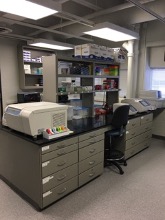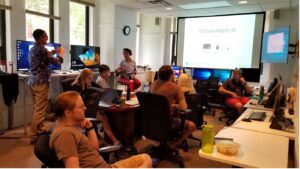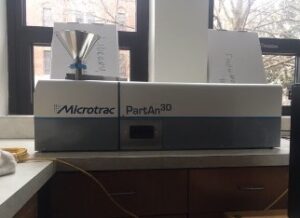Research Facilities
Genetic Anthropology and Biocultural Studies Laboratory (GABS Lab)
 The Genetic Anthropology and Biocultural Studies Laboratory (GABS Lab) is the research lab of Jada Benn Torres (Associate Professor of Anthropology). In the GABS Lab, our focus is on biological anthropological research on genetic ancestry and women’s health disparities in the United States and Caribbean populations. Our research foci are the following:
The Genetic Anthropology and Biocultural Studies Laboratory (GABS Lab) is the research lab of Jada Benn Torres (Associate Professor of Anthropology). In the GABS Lab, our focus is on biological anthropological research on genetic ancestry and women’s health disparities in the United States and Caribbean populations. Our research foci are the following:
- Genetics and Ethnogenesis: Using population genetic perspectives, we study how culture and biology come together to shape community history and experience.
- Race and Health: We use epidemiological approaches and anthropological insights on identity and genetics to address broader medically related questions.
- Genetics in Society: We consider the broader societal interfaces between genetic data, local knowledge, and identity politics.
The GABS lab consists of two facilities: one modern and one restricted access ancient (aDNA) genetics laboratory. The labs are housed on the 5th floor of Stevenson Center 2 on Vanderbilt University’s main campus.
The modern DNA lab is approximately 800 square feet and includes a 126-square-foot office for graduate students. This lab space is equipped for basic molecular genetic applications including DNA extraction/purification, PCR, RFLP, and gel electrophoresis (see Major Equipment below). The modern lab space is organized so that there are dedicated areas and equipment for pre and post PCR applications.
Bioarchaeology and Stable Isotope Research Lab (BSIRL)
 The Vanderbilt Bioarchaeology Stable Isotope Research Lab (BSIRL), directed by Tiffiny Tung, Gertrude Conaway Vanderbilt Professor of Anthropology, prepares bone and dental samples from humans, animals, and plants from various archaeology sites in the Americas, primarily from Peru, Bolivia, and Guatemala, where many of our faculty and graduate students conduct research. We prepare bone collagen for carbon and nitrogen isotope analyses, bone apatite (carbonates) for carbon and oxygen, and dental apatite (carbonates) for carbon and oxygen. These prepared samples are subsequently analyzed at the Yale Analytical and Stable Isotope Center. BSIRL is located in the Stevenson Center.
The Vanderbilt Bioarchaeology Stable Isotope Research Lab (BSIRL), directed by Tiffiny Tung, Gertrude Conaway Vanderbilt Professor of Anthropology, prepares bone and dental samples from humans, animals, and plants from various archaeology sites in the Americas, primarily from Peru, Bolivia, and Guatemala, where many of our faculty and graduate students conduct research. We prepare bone collagen for carbon and nitrogen isotope analyses, bone apatite (carbonates) for carbon and oxygen, and dental apatite (carbonates) for carbon and oxygen. These prepared samples are subsequently analyzed at the Yale Analytical and Stable Isotope Center. BSIRL is located in the Stevenson Center.
Osteology Research and Teaching Lab
T he Osteology Research and Teaching Lab houses medical human skeletons, isolated human skeletal and dental elements, monkey and ape skeletons, other animal skeletons, as well as a large collection of hominid casts. Lab equipment includes sliding and spreading calipers, osteometric board, mandibulometer, light table for viewing radiographs, photo stand, dental casts, the Suchey-Brooks pubic symphysis casts, and a variety of skeletal casts exhibiting pathological lesions, fractures, and cultural modifications (e.g., cranial modification and trepanation).
he Osteology Research and Teaching Lab houses medical human skeletons, isolated human skeletal and dental elements, monkey and ape skeletons, other animal skeletons, as well as a large collection of hominid casts. Lab equipment includes sliding and spreading calipers, osteometric board, mandibulometer, light table for viewing radiographs, photo stand, dental casts, the Suchey-Brooks pubic symphysis casts, and a variety of skeletal casts exhibiting pathological lesions, fractures, and cultural modifications (e.g., cranial modification and trepanation).
Spatial Analysis Research Lab (SARL)
 SARL is the research laboratory of Steve Wernke (Professor and Chair, Department of Anthropology). Our diverse team pursues insights into human social dynamics over a range of spatial and temporal scales through geospatial modeling and analysis. We investigate the political and historical ecology of colonialism, the co-production of communities, states, and their (built) environments, processes of human-environment interaction and landscape dynamics over varied spatio-temporal scales, and the phenomenology of place, among other themes. With funding from NSF, NEH, ACLS, NIH and other agencies, our work increasingly incorporates AI into our geospatial and remote sensing workflows. As an advanced geospatial computational facility, SARL is outfitted with eleven workstations, several servers, and geospatial field instrumentation.
SARL is the research laboratory of Steve Wernke (Professor and Chair, Department of Anthropology). Our diverse team pursues insights into human social dynamics over a range of spatial and temporal scales through geospatial modeling and analysis. We investigate the political and historical ecology of colonialism, the co-production of communities, states, and their (built) environments, processes of human-environment interaction and landscape dynamics over varied spatio-temporal scales, and the phenomenology of place, among other themes. With funding from NSF, NEH, ACLS, NIH and other agencies, our work increasingly incorporates AI into our geospatial and remote sensing workflows. As an advanced geospatial computational facility, SARL is outfitted with eleven workstations, several servers, and geospatial field instrumentation.
VISR is a geospatial consultancy with a large and diverse portfolio of projects. As a Vanderbilt core research facility, VISR provides geospatial analysis and geophysical survey for the Vanderbilt community and globally. VISR leverages our geospatial expertise and advanced geospatial computational capabilities to deliver spatial and geophysical insights across the social sciences, medicine, public health, humanities, STEM education, environmental science, engineering, and other disciplines. Our projects include both field-based geophysical survey, land survey, aerial survey, and lab-based modeling and analytics. VISR is directed by Steve Wernke, and managed by Natalie Robbins.
Culture and Cognition Lab
Directed by Professor Norbert Ross, the Culture and Cognition Lab focuses on the intersection of culture and cognition, combining theories and methods from different fields such as anthropology, the cognitive sciences, and linguistics. Housed in 320B Center Building, the lab offers computer spaces and meeting space for formal and informal discussions.
Much, yet not all, of the work is based on research with children, and how they develop their knowledge, values, goals, and ambitions. The work is characterized by a combination of different methods, including quantitative experimental work and long term ethnography.
From the cognitive sciences, the approach shares an interest in questions of how the mind works and, as a result, how the mind interacts with human social life in producing knowledge. In this approach psychology is important, yet it is imperative to realize that anthropology is not psychology writ large.
From anthropology, the research takes both a focus on ethnography as well as an approach that places social interactions and their outcomes center stage. It questions at times the stability and foundations of representations (as conceived in the cognitive sciences and elicited by experimental methods) by exploring them in their social and political context of identity formation and meaning-making. This, in turn, feeds back into our understanding of the mind.
Work in the lab does include computer modeling, and depending on the project includes GIS analyses (Hertzog & Ross 2017), yet all the work is solidly grounded in anthropological theory.
Past projects included work on folkbiology, resource management, and intergroup conflict over resource management. Former and current graduate students explore or have explored Machiguenka (Peru) notions of environment (Revilla-Minaya), the impact of schools on youth ambitions and knowledge of the environment in Ecuador (Shenton), evolution education in Tennessee (Tidwell), values and prestige in the Highlands of Chiapas, Mexico (Hertzog), and the multifold interactions of knowledge, identity, and legal repercussions of migrant farm workers in the U.S. (Korsunsky). Other work included research on change in folk-medical models both among Hispanics in the U.S. and central Mexico (Ross, Maupin & Timura), the role of language in cognition and culture (Ross, Hertzog, Shenton & Tidwell), and the formation and transformation of ontological commitments (Ross).
Current research deals with how children in El Salvador are affected by, cope with, and create defense mechanisms to protect themselves from high levels of violence. The research explores how violence affects their lives, how they understand and deal with it, and how it factors in to children’s identity formation. The project includes experimental work, ethnography, and theatre work. For more information contact Norbert Ross, associate professor of anthropology.
Microartifacts Lab

In the Microartifacts Lab (Stevenson SC2), Markus Eberl, assistant professor of anthropology, analyzes ‘invisible’ artifacts with the help of the PartAn3D, a dynamic image particle analyzer. Eberl and his team collect soils, mortars, and other granular dry materials from archaeological sites and use the PartAn3D to measure several dozen variables for each particle in a sample. To define the shape of the ancient artifacts Eberl and his team are looking for, they use experiments.
In 2019, the lab invited stone knapper Mike McBride to make stone tools from chert and obsidian. They have also participated in knap-ins and collected all the debris that the stone knappers produced and used it to define stone-knapping debitage. Machine learning and other data science approaches then allow Eberl and his team to identify these microartifacts in archaeological samples.
Material and Archaeological Sciences Laboratory (MAS Lab)
MAS Lab, directed by Michelle Young (Assistant Professor of Anthropology) applies innovative materials analysis techniques to archaeological remains to unlock new insights about past human societies. The lab’s work bridges the humanities and sciences, using physical evidence to illuminate human history through material culture, with specialization in composition, craft technology, and sourcing of ceramics and pigments of the ancient Americas. We offer analytical services to archaeological projects worldwide and training for graduate students in advanced materials characterization methods.
